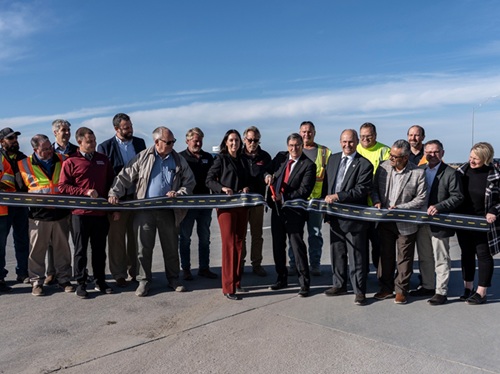Purdue University researchers, with funding from the Indiana Department of Transportation, recently developed a fully automated, portable system to estimate stockpile volumes of bulk supplies such as salt and other materials used in industrial, highway, and agricultural applications.
[Above photo by Purdue University]
Jeremy McGuffey, INDOT’s winter operations manager, noted in a statement that his department has nearly 120 salt storage buildings around the state and that most locations visually estimate the volume.

“This is inherently incorrect and will vary from person to person,” McGuffey said. “If I pointed to a pile of stone on the ground, could another person accurately tell me the volume of that stone based on sight alone?”
He added that while a few of INDOT’s locations use survey equipment to take volumetric measurements based on the exterior size – the height and width – of the stockpile, but those don’t account for depth.
“Many of our buildings are full of salt year-round and there is no way to reach the back side of the pile to determine how long it is,” McGuffey said.
A paper about Purdue’s innovation – published in the journal “Remote Sensing” – explains that its new salt monitoring and reporting technology, or SMART, integrates consumer-grade sensing modalities of imaging with light detection and ranging or LiDAR technology to acquire stockpile data in fewer than 10 minutes per facility, even in challenging environmental situations.

“SMART also uses an innovative data-processing strategy that can handle this data for accurate evaluation of stockpile volume as well as provide a visual record of the mapped facility in the form of colorized point clouds,” explained Ayman Habib, a Purdue civil engineering professor, who helped develop the SMART system with fellow professor Darcy Bullock.
“The technology estimates volume with less than 1 percent error and costs less than $10,000; existing technologies cost more than twice that,” Habib said. “It also allows for practical, quick and safe data acquisition. Some traditional technologies require an operator to climb the stockpile, which leads to extended and unsafe data acquisition.”
McGuffey said SMART is already helping INDOT better manage its salt stockpiles.
“With the system we developed with Purdue, the empty dimensions of the building are solved for first, and then the salt pile’s volume can be easily calculated. The LiDAR system bounces light off the pile millions of times to collect the information we need to determine the volume,” he noted. “The other huge plus is that this system is mostly automated with the only real human interaction being the initial install and then periodic cleaning.”
This is one of several INDOT/Purdue research projects delivering transportation benefits. In February, they unveiled a new wireless communication device that could help save lives at high-speed traffic signals.
 States
States
Kris Strickler to Step Down as Oregon DOT Director
November 14, 2025 States
States

